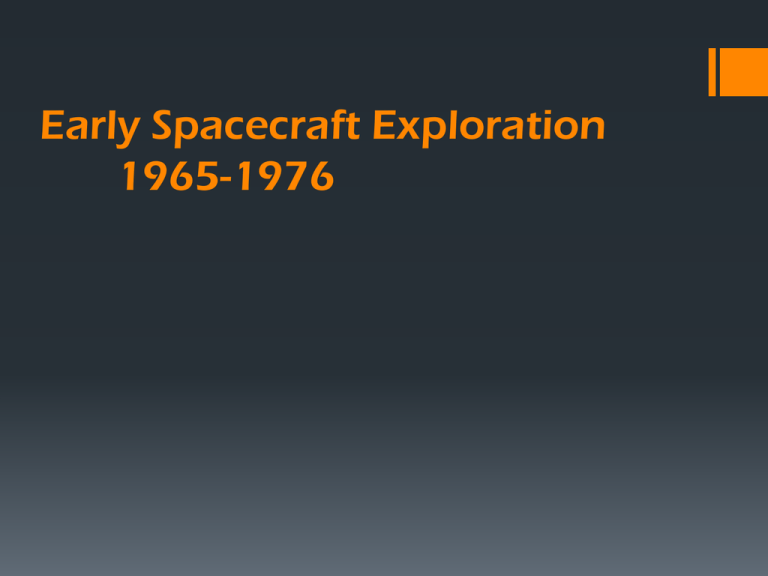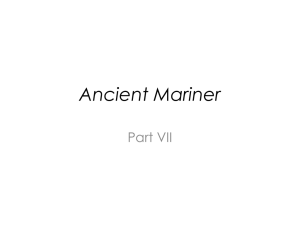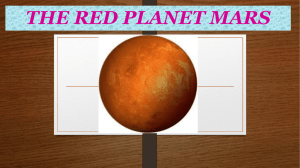Early Exploration Mariner 3 & 4
advertisement

Early Spacecraft Exploration 1965-1976 Early Spacecraft Exploration Mariner 3 & 4 “…these missions are being undertaken because Mars is of physical and geological interest and offers the best opportunity in our solar system for shedding light on the possibility of extraterrestrial life. (They)…, however, are not designed to provide answers to the question of life on Mars.” Mariner 4 Press Kit, October 29, 1964 Early Spacecraft Exploration Mariner 4 Launched November 24, 1964; closest approach occurred on July 14, 1965 Took 22 pictures w/ a TV camera (Mars TV Camera) viewing through a reflecting telescope Early Spacecraft Exploration Mariner 4 Other instruments: Magnetometer Geiger Count Cosmic Ray Telescope Solar Plasma Probe Cosmic Dust Detector Occultation Experiment Early Spacecraft Exploration Mariner 4 DATA!! Early Spacecraft Exploration Mariner 4 Early Spacecraft Exploration Mariner 4 Early Spacecraft Exploration Mariner 4 • • • • • • • How would you rate the quality of these images? What observations can you make? How would you interpret these observations? What can you say we know about Mars at this point? How certain are you? What questions would you ask about Mars? How would you attempt to answer these questions? What are the limitations to this type of mission (spacecraft/instruments)? Early Spacecraft Exploration Mariner 4 Notable observations from Mariner 4 Images returned showed a Moon-like, cratered terrain Surface atmospheric pressure of 4.1 to 7.0 mb and daytime temperatures of -100° C (-148° F) were estimated No magnetic field was detected Early Spacecraft Exploration Mariner 4 How did Mariner 4 advance scientific understanding of Mars? Mars looked more like the Moon Life far less likely IMPORTANT: Mariner 4 only imaged ~1% of the surface of Mars, mostly in the southern hemisphere What technological advance(s) did Mariner 4 carry? The Mariner 4 spacecraft Early Spacecraft Exploration Mariner 6 & 7 “Study the surface and atmosphere of Mars to establish the basis for future experiments in the search for extraterrestrial life and to develop technology for future Mars missions. The 1969 flights will not determine the presence of life on Mars but will help establish whether or not the Martian environment is suitable for life.” Mariner (6 & 7) Press Kit, July 18, 1969 Early Spacecraft Exploration Mariner 6 & 7 Launched February 23 (M6) & March 27, 1969 (M7) Close approaches occurred July 31 (M6) & August 5 (M7), 1969 Early Spacecraft Exploration Mariner 6 & 7 Two TV cameras – medium & high resolution IR radiometer (surface temps, is southern cap CO2 or H2O?) UV spectrometer (atmospheric composition) IR spectrometer (surface & near-surface composition) Early Spaceraft Exploration Mariner 6 & 7 DATA!! Early Spacecraft Exploration Mariner 6 & 7 Early Spacecraft Exploration Mariner 6 & 7 Mariner 7 approach of Mars Early Spacecraft Exploration Mariner 6 & 7 Early Spacecraft Exploration Mariner 6 & 7 • • • • • • • How would you rate the quality of these images? What observations can you make? How would you interpret these observations? What can you say we know about Mars at this point? How certain are you? What questions would you ask about Mars? How would you attempt to answer these questions? What are the limitations to this type of mission (spacecraft/instruments)? Early Spacecraft Exploration Mariner 6 & 7 Notable observations from the Mariner 6 & 7 missions report Temps range between -73° C (-100° F) & 15° C (60° F) The polar cap was crusted with frozen carbon dioxide… Features with a dimension of 900 (ft.) could be identified. The so-called Martian canals were not in evidence. At a location called Nix Olympica…was a huge crater 300 miles in diameter. No indications of volcanism were found. Mariner 6 & 7 imaged 20% of the surface of Mars, mostly in the southern hemisphere Early Spacecraft Exploration Mariner 6 & 7 How did Mariner 6 & 7 advance scientific understanding of Mars? Temperature range South polar cap composed of CO2; temp reading of -123°C (-190°F) NO CANALS What technological advance(s) did Mariner 6 & 7 carry? Spacecraft with higher resolution cameras & spectrometers Let’s take a break… CRATER BOXES!!! Early Spacecraft Exploration Mariner 8 & 9 “Study the surface and atmosphere of Mars in detail, and over a period of time, to provide a broad picture of the history of the planet and natural processes currently shaping the Martian environment. To accomplish this, one spacecraft will map 70% of the planet and the other will repeatedly study selected areas on Mars to observe changes on the surface and in the atmosphere.” Mariner (8 & 9) Press Kit, April 30, 1971 Early Spacecraft Exploration Mariner 8 & 9 Launched May 8 (M8) & May 30, 1971 (M9) Mariner 8 failed 4.5 minutes after launch, Mariner 9 arrived at Mars on November 14, 1971 Early Spacecraft Exploration Mariner 8 & 9 Visual Imaging System; narrow-angle and wide-angle TV cameras IR radiometer (surface temps) UV spectrometer (composition of upper atmosphere) IR interferometer spectrometer (provide a picture of the circulation of the atmosphere & composition of the surface) Early Spacecraft Exploration Mariner 8 & 9 DATA!! Early Spacecraft Exploration Mariner 9 • • • • • • • How would you rate the quality of these images? What observations can you make? How would you interpret these observations? What can you say we know about Mars at this point? How certain are you? What questions would you ask about Mars? How would you attempt to answer these questions? What are the limitations to this type of mission (spacecraft/instruments)? Early Spacecraft Exploration Mariner 9 Arrived at Mars only to find a global dust storm blanketing the planet Circular features peaking through the dust Early Spacecraft Exploration Mariner 9 Early Spacecraft Exploration Mariner 9 Olympus Mons Caldera Complex Early Spacecraft Exploration Mariner 9 Noctis Labyrinthus at the eastern edge of the Tharsis bulge; western end of Valles Marineris Early Spacecraft Exploration Mariner 9 Northern Polar Cap Early Spacecraft Exploration Mariner 9 Irregular pits and depressions near the south pole Early Spacecraft Exploration Mariner 9 Notable results from Mariner 9 Global mapping (imaging) of the surface of Mars The first detailed views of the Martian volcanoes, Valles Marineris, the polar caps, and the satellites Phobos and Deimos Provided information on global dust storms, the planet’s rugged gravity field, and evidence for surface aeolian (wind) activity. Early Spacecraft Exploration Mariner 9 Olympus Mons 27 km tall (16.8 miles), 600 km (373 miles) wide Shield volcano composed of basalt Largest (known) volcano in the solar system Early Spacecraft Exploration Mariner 9 Valles Marineris 4,000 km long (2,500 miles), 200 km (124 miles) wide, 7 km (4 miles) deep Large crack resulting from uplift of Tharsis bulge Named after Mariner 9 Early Spacecraft Exploration Mariner 9 Tharsis Bulge Credit: NASA/Goddard Space Flight Center Early Exploration Mariner 9 How did Mariner 9 advance scientific understanding of Mars? Mars is more geologically diverse than had ever been presumed Evidence water once flowed on the surface, not in artificial canals, but natural river channels What technological advance(s) did Mariner 9 carry? Spacecraft orbited Mars, first unmanned planetary orbiter in history











